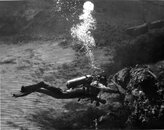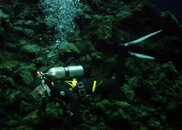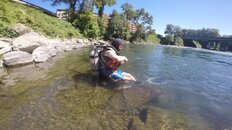I get a kick out of watching the guys and gals with "perfect trim" in the water, as they are using DIR techniques developed for a specific type of diving, cave diving. It is now applied to diving on coral reefs too, as this is the least damaging way of diving for the coral reefs. So there is good reason to dive that way.
But I dive mostly in rivers and estuaries of the Pacific Northwest of the USA (Oregon, specifically). There really is nothing to damage with my fins. The "perfect trim" divers who try their techniques under a river rapids will be spun around by the crosswise current racing above me at times.
The "frog kick" is a very inefficient type of kick, as it does not propel a diver very well. It is meant to conserve air by minimizing motion, but in a river it will rapidly result in the diver being swept downstream.
Not kneeling on the bottom is again to protect both the diver and the small, delicate corals from damage. You don't want to kneel on an urchin, for instance. But if you are in a river, with a large rock protecting you from a very fast current, kneeling in the rock's eddy may be the best way of dealing with the situation.
I sometimes dive lakes, and in Oregon there is none clearer then Clear Lake on the McKenzie pass in the Cascade mountains. Here, the DIR techniques are very valuable, as the bottom is very easily stirred up, being volcanic ash left over from eruptions centuries ago. If other divers are to enjoy the clarity, the previous divers should stay off the bottom and use the "perfect trim" techniques to avoid stirring up the silt.
What am I saying? Well, we need all the different tools in our diving repertoire. Sometimes "perfect trim" is necessary, or an advantage. Sometimes, however, this concept can be a detriment. Divers need training to use the correct technique for the situation. If you are trying to swim hard to catch a boat, or the hoist of a helicopter, you may not want to try a frog kick on the surface. But if you are enjoying the natural beauty of a wonderful place like Clear Lake, a frog kick is very appropriate.
SeaRat







